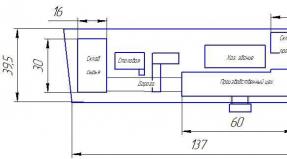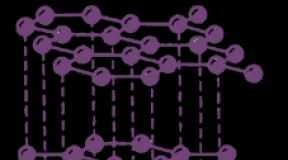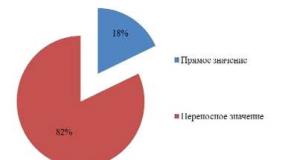Amitriptyline treatment. Amitriptyline is a dangerous drug. Action and indications
Amitriptyline is a drug belonging to the group of non-selective monoamine uptake inhibitors, used in the presence of depression of various origins, as well as in other diseases of the central nervous system and organs. gastrointestinal tract.
Composition and form of release
The active substance in this drug is amitriptyline hydrochloride. The content of this component is: 11.32 mg, or 28.3 mg in each tablet or in 1 ml of solution.
Among the auxiliary agents, it should be noted the presence of such compounds as: microcrystalline cellulose, lactose monohydrate, pregelatinized corn starch, colloidal silicon dioxide, purified medical talc, magnesium stearate.
In solutions, excipients are represented by water for injection and dextrose. Vacation is carried out strictly according to the prescription of the attending physician.
pharmachologic effect Amitriptyline
Given medicinal substance It has a whole range of effects on the human body: antidepressant, analgesic, antihistamine, antiserotonin, and some others.
The antidepressant effect is due to the suppression of the reuptake of neurotransmitters: norepinephrine and serotonin, which leads to an increase in the concentration of these substances in the synaptic cleft. As a result, the transmission process is normalized nerve impulse from one neuron to another, which improves the functioning of the nervous system.
This effect is expressed in reducing the severity of depressive states, suppressing anxiety, improving mood and other positive effects.
The antihistamine effect is due to the partial blocking of histamine receptors located in the parietal cells of the gastric mucosa. This circumstance affects the intensity of production of hydrochloric acid, and acceleration of regenerative processes, which can have positive impact in the presence of an ulcer or hyperacid gastritis.
An increase in the concentration of serotonin in the synapses of the central nervous system is the cause of the onset of an analgesic effect. Perhaps there is also a stimulation of the activity of internal opioid systems.
The drug can also be used in the presence of bulimia nervosa, and this disease does not have to be accompanied by depressive symptoms.
The antidepressant effect develops already after 2 or 3 weeks from the start of the use of Amitriptyline and lasts throughout the entire period of taking this medication.
Indications for use
Appointment of Amitriptyline is made in the presence of the following indications:
Depression of various origins, including severe anxiety, sleep disorders, and so on;
Organic lesions of the central nervous system, complicated by the presence of a depressive state;
As part complex therapy with schizophrenia and psychosis;
Nocturnal enuresis;
bulimia nervosa;
Chronic pain syndrome in patients with severe cancer;
Migraine conditions;
peptic ulcer stomach and duodenum.
To prescribe this remedy, as well as to evaluate the effectiveness of its use, should be a specialist with appropriate experience. Uncontrolled use is fraught with negative consequences.
Contraindications for use
Appointment of Amitriptyline cannot be carried out in the presence of the following conditions:
Hypersensitivity to any component of the drug;
Simultaneous use of drugs - monoamine oxidase inhibitors;
Gross violations of cardiac conduction;
Angle-closure glaucoma;
The patient's age is less than 6 years.
Relative contraindications are such conditions: alcoholism, severe bronchial asthma, some forms of schizophrenia, epilepsy, severe angina pectoris, increased arterial pressure, intestinal obstruction, acute urinary retention in prostate adenoma and other conditions.
Treatment with Amitriptyline
Application, dosage and reception of Amitriptyline
Tablets should be taken after meals without chewing. You can drink the right amount of plain water. Adult patients with depressive states should be prescribed 25-50 mg once at night.
In the presence of positive dynamics, the dosage can be raised to 300 mg per day. It should be remembered that most of the medicine should be taken at night. The duration of therapy is determined by the attending physician, and depends on the patient's response to the drug used.
In the form of solutions, Amitriptyline is used according to the following scheme: 10-30 mg of the drug is administered intramuscularly, up to 4 times a day. If necessary, the dose can be increased to 150 mg per day. After a couple of weeks, you should switch to the use of tablet forms.
Overdose
Signs of Amitriptyline poisoning: confusion up to coma, hyperthermia, drowsiness, drop in blood pressure, hallucinations, convulsions, vomiting, pathology heart rate.
In this case, you need to stop using the medicine, conduct infusion therapy, and take all measures aimed at maintaining the functioning of vital organs.
Side effects
From the side of the central nervous system: fatigue, weakness, dizziness, drowsiness, tinnitus, sleep disorders, convulsions, and so on.
From the organs digestive system: nausea, vomiting, heartburn, lesions of the oral mucosa, discoloration of the tongue, stomach pain, liver damage.
Other side effects: allergic reactions, changes in the hemogram, deviations in the electrocardiogram, decreased libido and other undesirable manifestations.
Analogues
Analogues of the drug Amitriptyline are the following drugs: Amizol, Amirol, Amitriptyline hydrochloride, Apo-Amitriptyline, Saroten retard, Tryptisol, Elivel.
Conclusion
In the treatment of diseases of the central nervous system, it is extremely important to punctually follow all the doctor's instructions, both in terms of the use of medicines, and in relation to the regime of work and rest, nutrition, and so on.
With depression, fear or insomnia, doctors often prescribe the drug "Amitriptyline" to their patients. It is believed that this remedy copes well with various pathological conditions of the psyche. This medicine is supplied to the market in the form of tablets or solution.
Reviews from consumers "Amitriptyline" deserved relatively good. It really helps with anxiety. However, there are still quite a few contraindications for this remedy. The same goes for side effects. Therefore, some patients, of course, would like to know what modern, more gentle analogues of Amitriptyline are on the market.
In what cases is it assigned
Indications for the use of "Amitripilin" are, for example, diseases such as:
depressive state;
fears and phobias;
anorexia and bulimia;
migraine.
Sometimes this remedy is also prescribed for children with enuresis.
This rather strong medicine should be prescribed exclusively by the attending physician. It actually has a lot of side effects. Patients taking the drug "Amitriptyline" often experience:
blurred vision;
constipation and intestinal obstruction;
lethargy and drowsiness;
dizziness and low blood pressure;
tachycardia;
weakness;
decreased libido.
Also, people taking a course using this remedy may experience fainting.

There are also quite a few contraindications for this drug. For example, he is not assigned to patients if they have problems such as:
intestinal obstruction;
blood diseases;
glaucoma;
diseases Bladder.
With caution, this medicine is prescribed for schizophrenia, bronchial asthma, epilepsy and some other diseases.
Instructions for use
This medicine is supplied to the market in tablets or in the form of a solution. Doctors usually prescribe it first in small doses. Then the amount of the drug taken per day is increased. The initial dose of this remedy is most often 25-50 mg. In the future, the amount of medication taken is gradually increased to 300 mg. Patients take this dose three times a day.
Most analogues of "Amitriptyline" instructions for use are similar. In any case, the dose of many antidepressants is usually increased gradually.
Reviews about the tool "Amitriptyline"
The advantage of this drug, patients consider, first of all, of course, that it helps very well with various mental disorders. Many consider this medicine even perhaps the most powerful antidepressant to date. Also, the advantages of this drug include its relatively low cost.
The disadvantages of "Amitriptyline" are considered:
the ability to quickly get used to;
decrease in blood pressure;
severe drowsiness;
dry mouth.
It is precisely because of the ability to have so many side effects that Amitriptyline deserved, first of all, not too good reviews from patients. The instructions for analogues of this drug are usually similar, but in many cases they still act on the body of patients, they are much milder than this powerful medicine.
Also, the disadvantage of this remedy, many people who have ever taken it, consider that it has a narcotic effect on patients. Not too much good feedback"Amitriptyline" deserved and for its ability to cause in patients undergoing treatment with its use, just a brutal appetite.
The best analogues of "Amitriptyline"
The side effects of this medicine are therefore many. Therefore, patients are often interested in what safer analogues it has. Most often, if necessary, instead of the drug "Amitriptyline", doctors prescribe the following to patients:sparingmodern facilities:
« Anafranil".
"Saroten".
"Doxepin".
Melipramin.
"Novo-Triptin".
Unfortunately, there are no modern analogues of Amitriptyline without side effects. All antidepressants in one way or another are able to have a negative impact on the patient's body. All analogues from the list, of course, also give side effects and are contraindicated in certain diseases. But they still cause undesirable reactions of the body somewhat less frequently than Amitriptyline.
The drug "Anafranil": indications and contraindications
Like "Amitriptyline", "Anafranil" is supplied to the market in the form of a solution and tablets. It belongs to the group of tricyclic antidepressants. Doctors prescribe it in the same cases as Amitriptyline. That is, depression panic attacks, psychomotor retardation.

Contraindications to the use of this analogue of "Amitriptyline" are:
intolerance to its components;
lactation period;
recovery period after a heart attack.
Do not prescribe this drug also to children under 5 years of age. In addition, it is forbidden to take an analogue of the new generation of Amitriptyline simultaneously with drugs from the group of MAO inhibitors.
What negative effect can it have on the body
The side effects of this drug are not as many as those of Amitriptyline, but still they can sometimes occur. Therefore, it is also necessary to take this remedy, of course, only as directed by a doctor. For example, sometimes during treatment with Anafranil, patients experience tachycardia and blood pressure rises. But fortunately, this happens quite rarely. The most unpleasant side effects from taking this drug are swelling, skin rash and itching.
Reviews about the drug "Anafranil"
Many patients note the fact that this medicine for depression and fears helped them very well. It has a positive effect on some patients even in cases where other similar remedies remain powerless. According to patients, Anafranil helps very well both with panic attacks and with various kinds of depression.
Excellent reviews about the analog of "Amitriptyline" "Anafranil" on the Web are also available because this medicine practically does not cause addiction. But to reduce the dosage of this drug, according to people who have ever taken it, should still be smooth and gradual. To rather serious shortcomings of this remedy, patients mainly refer only to the fact that in the first days of taking it often causes dizziness.
What is the drug "Doxepin"
This analogue of "Amitriptyline" is prescribed to patients in the following cases:
with depression, including MDP;
excitement and anxiety;
hypochondria.
Also, this medicine can be used for panic disorders or sleep disorders. For children, the drug can be prescribed only from the age of 12. This medicine is supplied to the market in the form of tablets.

When you can not take "Doxepin" and what side effects it can cause
You can buy this analogue of "Amitriptyline" without a prescription in many pharmacies. However, it should be taken only after consulting a doctor. Contraindications for Doxepin, like many other antidepressants, of course, are available. For example, you can not take this remedy when:
hypersensitivity to components;
body intoxication different types, including alcohol;
breastfeeding;
the presence of liver or kidney failure.
Unfortunately, there are no analogues of "Anitriptyline" without side effects. "Doxepin" can cause during the course, among other things, nausea, problems with urination, drowsiness and weakness. In those patients for whom Doxepin is not suitable at all, spasms or uncontrolled shaking of body parts may occur when taking it. Sometimes this drug causes other side effects in patients.
Reviews about the analogue of "Amitriptyline" "Doxepine"
Patients also consider this drug to be quite effective. Especially well, according to patients, it helps with depression. The advantages of this medicine include its low cost. Judging by the reviews, this drug begins to help about two weeks after the start of administration.
To disadvantages modern analogue"Amitriptyline" "Doxepin" patients attribute the fact that at first it usually causes severe drowsiness. Also, after stopping this medicine, as noted by many people treated with it, there may be a not too strong, but still withdrawal effect. It is usually manifested by jumps in blood pressure.
There are relatively many side effects of this drug. Therefore, changing Amitriptyline to it is still worth it only if the latter is contraindicated for some reason, does not help, or has too negative an effect on the patient's body.
Which is better - "Doxepin" or "Anafranil"?
Compare drugs for treatment mental illness, is quite difficult. The choice of such drugs is usually very individual. A remedy that works well for one patient may be completely useless for another. That is why self-medication with the use of such means is considered very dangerous.
Be that as it may, both of the analogues of "Amitriptyline" discussed above for depression and anxiety, as can be judged by the reviews about them, can help patients quite well. The only thing is that "Doxepin" is still considered just a sedative for the most part. That is, it is best suited for the treatment of anxiety. "Anafranil" is referred to as a drug of balanced action. And consequently, the list of indications for use is wider.
The drug "Melipramine"
The main active substance of this drug is imipramine hydrochloride. Like Amitriptyline, it can be supplied to the market in the form of dragees or solutions intended for intramuscular injections. This drug is prescribed by doctors for:
depressions of various kinds;
panic disorder;
chronic pain syndrome (for example, in cancer patients);
rheumatism;
neuralgia;

Like Amitriptyline, Melipramine is good for enuresis. Like most other similar drugs, this analogue of Amitriptyline is supplied to the market in tablets and in the form of a solution for injection.
Contraindications and side effects of the drug "Melipramin"
For children, this medicine can only be prescribed from the age of 6 years. Contraindications to the use of the drug "Melipramin" are:
intoxication;
heart diseases;
lactation period.
Elderly people, as well as patients with schizophrenia, this drug is prescribed with caution.
Side effects "Melipramin" can cause such:
promotion intraocular pressure;
drowsiness;
hand tremor;
paralytic intestinal obstruction;
problems with urination.
At long-term use this drug can also cause such an unpleasant effect as the accelerated development of dental caries.
- Instructions for use Amitriptyline
- Ingredients of Amitriptyline
- Indications for Amitriptyline
- Storage conditions of the drug Amitriptyline
- Amitriptyline shelf life
Release form, composition and packaging
Reg. No: 10/02/1225 of 02/08/2010 - Expired
Coated tablets
Excipients:
The composition of the film shell:
coated tablets 25 mg: 50 pcs.Reg. No: 10/02/1225 dated 02/08/2010 - Canceled
Coated tablets blue, with a biconvex surface, with a risk on one side.
Excipients: lactose, corn starch, dibasic calcium phosphate, gelatin, talc, magnesium stearate, colloidal silicon dioxide, methyl paraben, polyethylene glycol 6000.
The composition of the film shell: Opadry Blue (hydroxypropyl methylcellulose, titanium dioxide (E 171), talc, propylene glycol, polyethylene glycol, brilliant blue (E 133)).
10 pieces. - cellular contour packings (5) - packs of cardboard.
50 pcs. - cans (1) - packs of cardboard.
Description medicinal product AMITRIPTYLINE was created in 2012 on the basis of instructions posted on the official website of the Ministry of Health of the Republic of Belarus. Date of update: 07.05.2013
Inhibits the reuptake of neurotransmitters (norepinephrine, serotonin, etc.) by presynaptic nerve endings of neurons, causes the accumulation of monoamines in the synaptic cleft and enhances postsynaptic impulses. With prolonged use, it reduces the functional activity (desensitization) of beta-adrenergic and serotonin receptors in the brain, normalizes adrenergic and serotopinergic transmission, restores the balance of these systems, disturbed during depressive states. Blocks m-cholinergic and histamine receptors of the central nervous system.
Absorption is high. The time to reach C max after ingestion is 4-8 hours. The bioavailability of the drug Amitriptyline is from 33 to 62%, its active metabolite nortriptyline is 46-70%. Vd 5-10 l/kg. Effective therapeutic concentrations in the blood of the drug Amitriptyline 50-250 ng / ml, for nortriptyline (its active metabolite) 50-150 ng / ml. C max in blood plasma - 0.04-0.16 μg / ml. Passes through histohematological barriers, including the blood-brain barrier (including nortriptyline). The concentration of the drug Amitriptyline in tissues is higher than in plasma. Communication with plasma proteins 92-96%. Metabolized in the liver (by demethylation, hydroxylation) with the formation of active metabolites - nortriptylia, 10-hydroxy-amitriptyline and inactive metabolites. T 1/2 from blood plasma from 10 to 28 hours for the drug Amitriptyline and from 16 to 80 hours for nortriptyline. Excreted by the kidneys - 80%, partly with bile. Complete elimination within 7-14 days. Amitriptyline crosses the placental barrier, is excreted in breast milk in concentrations similar to plasma.
- depression of any etiology. It is especially effective in anxiety-depressive states, due to the severity of the sedative effect. Does not cause an exacerbation of productive symptoms (delusions, hallucinations), unlike antidepressants with a stimulating effect;
- mixed emotional and behavioral disorders, phobic disorders;
- children's enuresis (with the exception of children with hypotonic bladder);
- psychogenic anorexia, bulimic neurosis;
- neurogenic pain of a chronic nature, for the prevention of migraine.
Assign inside (during or after a meal).
The initial daily dose when taken orally is 50-75 mg (25 mg in 2-3 doses), then the dose is gradually increased by 25-50 mg until the desired antidepressant effect is obtained.
The optimal daily therapeutic dose is 150-200 mg (the maximum part of the dose is taken at night). In severe depression resistant to therapy, the dose is increased to 300 mg or more, up to the maximum tolerated dose. In these cases, it is advisable to start treatment with intramuscular or intravenous administration of the drug, while using higher initial doses, accelerating the increase in dosages under the control of the somatic condition.
After obtaining a stable antidepressant effect after 2-4 weeks, the doses are gradually and slowly reduced. In the event of signs of depression with a decrease in doses, it is necessary to return to the previous dose. With a sudden discontinuation after prolonged treatment, withdrawal syndrome may develop. If the patient's condition does not improve within 3-4 weeks of treatment, then further therapy is inappropriate.
In elderly patients for mild disorders, in outpatient practice, doses are 25-50-100 mg (max) in divided doses or 1 time / day at night. For migraine prevention, chronic pain of a neurogenic nature(including prolonged headaches) from 12.5-25 mg to 100 mg / day.
children as an antidepressant:
- 6 to 12 years old- 10-30 mg / day or 1-5 mg / kg / day fractionally, in adolescence- 10 mg 3 times / day (if necessary, up to 100 mg / day).
For the treatment of nocturnal enuresis children over 6 years old- 12.5-25 mg at night (the dose should not exceed 2.5 mg / kg of body weight).
Mainly associated with the anticholinergic effect of the drug - disturbance of accommodation, increased intraocular pressure, dry mouth, stool retention, intestinal obstruction, urinary retention, fever, drowsiness. All these phenomena usually disappear after adaptation to the drug or dose reduction.
From the side of the central nervous system: drowsiness, dizziness, tremor.
From the side of the cardiovascular system: tachycardia, orthostatic hypotension, increased pressure, conduction disturbance, ECG changes.
allergic reactions: skin rash, etc.
From the gastrointestinal tract: nausea, vomiting, anorexia, stomatitis, taste disturbances, epigastric discomfort, rarely liver dysfunction.
From the endocrine system: gynecomastia, galactorrhea, changes in ADH secretion, decreased libido, potency.
Others: agranulocytosis and other blood changes, skin rash, hair loss, increased lymph nodes, weight gain with prolonged use.
Amitriptyline at doses above 150 mg / day reduces the threshold for seizure activity, so the risk of seizures should be considered in patients with a history of seizures, and in those patients who are predisposed to this due to age or injury.
Patients with a depressive phase of MDP may go into the manic stage.
Use during pregnancy and lactation
Contraindicated in pregnancy, lactation (when taking the drug during pregnancy and / or lactation, there may be a risk of congenital malformations and persistent pulmonary hypertension in newborns).
Increased risk of bone fractures over age 50.
Treatment of elderly patients with amitriptyline should be carried out under careful somatic control and with the use of minimal doses of the drug, which should be increased gradually, in order to avoid the development of delirious disorders, hypomania and other complications.
The drug is contraindicated in children under 6 years of age ( injection forms up to 12 years old).
Treatment with amitriptyline in children over 6 years of age should be carried out under careful somatic control using minimal doses of the drug, which should be increased gradually to avoid the development of delirious disorders, hypomania and other complications.
Before starting treatment, control of blood pressure is necessary (in patients with low or labile blood pressure, it may decrease even more); during treatment - control of peripheral blood (in some cases, agranulocytosis may develop, and therefore it is recommended to monitor the blood picture, especially with an increase in body temperature, the development of flu-like symptoms and tonsillitis), with long-term therapy - control of the functions of the cardiovascular system and liver . In the elderly and patients with diseases of the cardiovascular system, monitoring of heart rate, blood pressure, ECG is indicated. Clinically insignificant changes may appear on the ECG (smoothing of the T wave, depression segment S-T, expansion of the QRS complex).
Caution is required when making a sudden transition to vertical position from a lying or sitting position.
Due to possible cardiotoxic effects, caution is required when treating patients with thyrotoxicosis or patients receiving hormone preparations. thyroid gland.
Before performing general or local anesthesia, the anesthesiologist should be warned that the patient is taking amitriptyline.
Due to the anticholinergic effect, a decrease in tear production and a relative increase in the amount of mucus in the composition of the tear fluid are possible, which can lead to corneal damage in patients using contact lenses.
With prolonged use, there is an increase in the incidence of dental caries. The need for riboflavin may be increased.
Treatment with amitriptyline in the elderly and children should be carried out under careful somatic control and with the use of minimal doses of the drug, increasing them gradually, in order to avoid the development of delirious disorders, hypomania and other complications.
Due to the possibility of suicidal attempts in patients with depression, regular monitoring of patients is necessary, especially in the first weeks of treatment, as well as administration in the minimum required doses to reduce the risk of overdose. If there is no improvement in the patient's condition within 3-4 weeks, it is necessary to reconsider the tactics of treatment.
Do not drive while taking amitriptyline Vehicle, maintenance of mechanisms and other types of work that require increased concentration of attention. Alcohol should be avoided during treatment.
Reception of amitriptyline is possible no earlier than 14 days after the abolition of MAO inhibitors.
Symptoms: drowsiness, disorientation, confusion, hallucinations, delirium, dilated pupils, fever, shortness of breath, dysarthria, agitation, hallucinations, seizures, muscle rigidity, stupor, coma, vomiting, arrhythmia, hypotension, heart failure, respiratory depression.
Treatment: gastric lavage, taking a suspension of activated charcoal, laxatives, maintaining body temperature, monitoring the function of the cardiovascular system for at least 5 days, because relapse may occur after 48 hours or later.
With severe anticholinergic symptoms (hypotension, arrhythmia, coma) - the introduction of physostigmine 1-3 mg every 1/2-2 h / m or / in (for children, the administration of physostigmine begins with 0.5 mg, then the dose is repeated with a 5-minute interval for determination of the minimum effective dose, but not more than 2 mg). Physostigmine should only be used in comatose patients with respiratory depression, epileptic seizures, severe hypotension, and marked cardiac arrhythmias. Hemodialysis and forced diuresis are ineffective.
At joint application ethanol and drugs that depress the central nervous system (including antidepressants, barbiturates, benzodiazepines and general anesthetics), a significant increase in the inhibitory effect on the central nervous system, respiratory depression and hypotensive effect is possible. Increases sensitivity to drinks containing ethanol. Increases the m-anticholinergic effect of drugs with such activity (for example, phenothiazines, antiparkinsonian drugs, amantadine, atropine, biperiden, H1-histamine receptor blockers), which increases the risk of side effects (from the side of the central nervous system, the organ of vision, intestines and urinary bubble).
When used together with blockers of H1-histamine receptors, clonidine - increased inhibitory effect on the central nervous system; with atropine - increases the risk of paralytic ileus; with drugs that cause extrapyramidal reactions - an increase in the severity and frequency of extrapyramidal effects. With the simultaneous use of amitriptyline and indirect anticoagulants(derivatives of coumarin or indadione), an increase in the anticoagulant activity of the latter is possible.
Amitriptyline may exacerbate depression caused by glucocorticosteroids.
When used together with anticonvulsant drugs, it is possible to increase the inhibitory effect on the central nervous system, lower the threshold for convulsive activity (when used in high doses) and reduce the effectiveness of the latter.
Medicines for the treatment of thyrotoxicosis increase the risk of developing agranulocytosis.
Reduces the effectiveness of phenytoin and alpha-blockers.
Inhibitors of microsomal oxidation (cimetidine) lengthen T 1/2, increase the risk of developing toxic effects of amitriptyline (a dose reduction of 20-30% may be required), inducers of microsomal liver enzymes (barbiturates, carbamazipine, phenytoin, nicotine and oral contraceptives) reduce plasma concentration and reduce the effectiveness of amitriptyline.
Fluxetine and fluvoxamine increase plasma concentrations of amitriptyline (a dose reduction of amitriptyline by 50% may be required).
When used together with anticholinergics, phenothiazines and benzodiazepines - mutual enhancement of sedative and central anticholinergic effects and increased risk of epileptic seizures (lowering the threshold of convulsive activity); phenothiazines, in addition, may increase the risk of neuroleptic malignant syndrome.
With the simultaneous use of amitriptyline with clonidine, guanethidine, betanidine, reserpine and methyldopa, a decrease in the hypotensive effect of the latter; with cocaine - the risk of developing cardiac arrhythmias.
Combined use with disulfiram and other inhibitors of acetaldehyderogenase provokes delirium.
Incompatible with MAO inhibitors (possible increase in the frequency of periods of hyperpyrexia, severe convulsions, hypertensive crises and death of the patient).
Pimozide and probucol can exacerbate cardiac arrhythmias, which is manifested in lengthening interval Q-T on the ECG.
Enhances the effect on cardiovascular system epinephrine, norepinephrine, isoprenaline, ephedrine and phenylephrine (including when these drugs are part of local anesthetics) and increases the risk of developing heart rhythm disturbances, tachycardia, severe arterial hypertension.
When co-administered with alpha-agonists for intranasal administration or for use in ophthalmology (with significant absorption), it can enhance the vasoconstrictive effect of the latter.
When taken together with thyroid hormones - mutual reinforcement therapeutic effect and toxic action(include cardiac arrhythmias and stimulating effects on the central nervous system).
M-anticholinergics and antipsychotic drugs (neuroleptics) increase the risk of developing hyperpyrexia (especially in hot weather).
When co-administered with other hematotoxic drugs, hematotoxicity may increase.
A classic and highly effective tricyclic antidepressant is Amitriptyline Nycomed. Reviews about him are usually positive. This medicine has wide range applications.
pharmachologic effect
The drug "Amitriptyline" is an antidepressant from a number of tricyclic compounds. It is a derivative of dibenzocycloheptadine. The action of amitriptyline is associated with the stimulation of serotonergic and adrenergic mechanisms of the brain by suppressing the reuptake of mediators. It gives a sedative effect, exhibits antihistamine and anticholinergic activity. The antidiuretic benefit in nighttime incontinence is achieved through anticholinergic activity. The drug has an analgesic effect, which is believed to be associated with changes in the concentration of monoamines in the central nervous system and the effect of tricyclic compounds on opioid endogenous systems.
Pharmacokinetics
It is believed that the drug "Amitriptyline" has good bioavailability. Reviews usually confirm this. The bioavailability of the drug is 31-61%. It binds to blood proteins by 82-96%. Metabolization is carried out with the formation of the metabolite nortriptyline (active). The half-life is 31-46 hours. The drug is excreted mainly through the kidneys.

Indications
The drug is used during the depressive phase of manic-depressive psychoses, various depressions (including children's), with mixed emotional disorders, with pathological behavioral disorders. In children's enuresis (with the exception of patients with hypotonic bladder pathology), the medicine "Amitriptyline" has proven itself quite well. Reviews about its action are good. The drug is also prescribed for bulimia nervosa and chronic pain syndromes. Also, this remedy is prescribed for the treatment of bulimic neurosis, psychogenic anorexia, with chronic neurogenic pain, in order to prevent migraine.

Dosing
Amitriptyline tablets are taken orally (without chewing) after meals. For adults, the initial dose is 25 mg 2 to 4 times a day. The maximum dosage for outpatient treatment is 150 mg per day, for inpatient treatment - 300 mg per day, and for the elderly 100 mg. The medication can be administered intravenously or intramuscularly at a dose of 20-40 mg four times a day. Over time, injections can be replaced by oral administration. Course - no more than 6 months. For children, the drug is prescribed as an antidepressant in dosages of 10-30 mg, for adolescents - 10 mg three times a day, for the treatment of enuresis in children over six years of age - 12-25 mg at night. The dosage should not exceed the proportion of 2.5 mg per 1 kg of body weight.
Side effects
As a rule, the medicine "Amitriptyline" is well tolerated. Feedback on the use is positive. However, various side effects are possible. CNS: disorientation, hallucinations, drowsiness, extrapyramidal disorders, fatigue, anxiety, trembling. Cardiovascular system: tachycardia, orthostatic hypotension, conduction disturbance. Gastrointestinal: cholestatic jaundice, vomiting, stomatitis. Reproductive system: delayed ejaculation, various disorders, changes in libido, decreased potency. Endocrine system: diabetes, glucosuria, hyperglycemia, decreased glucose tolerance, inadequate ADH secretion. Metabolism: weight gain. Allergic reactions: skin rashes, itching. Effects caused by anticholinergic activity: disturbances of accommodation, dry mouth, urinary retention, increased intraocular pressure, blurred vision, constipation. Side effects occur infrequently when taking the medication "Amitriptyline". Reviews about it are generally positive.

Contraindications
The drug should not be prescribed against the background of the following diseases: with angle-closure glaucoma, atony of the bladder, prostate hypertrophy, paralytic ileus, pyloric stenosis, epilepsy, early recovery period after a heart attack. The drug also can not be used simultaneously with MAO inhibitors. It is also contraindicated to use the drug for decompensated heart defects, blood diseases, glaucoma, severe liver and kidney diseases, stomach ulcers and hypersensitivity to the active substance and other components of the medication.

Pregnancy and lactation
The drug "Amitriptyline" should not be used during pregnancy, and especially in the 1-3 trimesters. The use of the drug is allowed only when absolutely necessary. The point is that adequate clinical research the effect of the drug on the fetus and the mother's body was not carried out. Therefore, it is not known how safe it is. In experimental studies, the drug gave a teratogenic effect in dosages much higher than normal.
special instructions
With great care, this drug is used for heart failure, arrhythmias, coronary artery disease. Abrupt discontinuation of medication can lead to the development of a withdrawal syndrome. This tool can be used no earlier than two weeks after taking MAO inhibitors. You can not use the drug simultaneously with sympathomimetic medications: with epinephrine, isoprenaline, ephedrine, phenylephrine, norepinephrine, phenylpropanolamine. With great care, this medicine is prescribed together with drugs that have an anticholinergic effect. Do not drink alcohol while taking the medication. Means "Amitriptyline" affects the ability to control mechanisms. During therapy, it is necessary to refrain from activities associated with a potential hazard, requiring a good reaction rate and increased attention. This drug was included in the list of vital drugs. With an overdose of Amitriptyline, the following symptoms are observed: disorientation, drowsiness and confusion, fever, dysarthria, shortness of breath, dilated pupils, hallucinations, stupor, convulsions, arrhythmia, muscle rigidity, hypotension, respiratory depression, heart failure.

drug interaction
As a rule, with the simultaneous use of Amitriptyline with other drugs that have a depressant effect on the central nervous system, as well as with alcohol, an excessive increase in depression of the central nervous system is possible. The effect of alcohol is enhanced. In addition, hypotensive effects and respiratory depression may be observed. If you take the medicine together with other drugs that are characterized by anticholinergic activity, it is possible to increase the anticholinergic effect. Taking the drug "Amitriptyline" with symptomatic medications enhances their effect on the heart and the cardiovascular system as a whole. Because of this, the risk of developing various rhythm disturbances, arterial hypertension (severe forms), and tachycardia increases. Reception with guanethidine and clonidine reduces the hypotensive effect of these drugs. Use together with barbiturates: with quinidine - slowing down the metabolism of the drug "Amitriptyline", with carbozepine - a significant decrease in the effect of the drug due to a strong acceleration of its metabolism. Simultaneous use together with cimetidine also slows down the metabolism of Amitriptyline, and also increases its plasma concentration and increases the risk of toxic effects.
Title on Latin– amitriptyline.
The active substance is amitriptyline.
Pharmacological properties - an antidepressant, a non-selective inhibitor of the reuptake of norepinephrine and serotonin.
Manufacturers - Moscow Endocrine Plant, ALSI Pharma, Ozone, Dalchimpharm, ZiO-Health, Moskhimfarmpreparaty im. N. A. Semashko, Grindeks (Latvia), Zentiva (Czech Republic), Takeda (Japan), Sintez, Bryntsalov-A, Apotex Inc. (Canada), Veropharm, H. Lundbeck A/O (Denmark).
Amitriptyline is a classic tricyclic antidepressant. The drug was synthesized one of the first, it is called the "old antidepressant". However, even today, the drug occupies a leading position in the treatment of severe depression and chronic pain syndromes. The advantage of amitriptyline is a pronounced dual effect on serotonin and norepinephrine. This provides a high efficacy of the drug both in the case of depression and chronic pain. However, the drug has a number of contraindications and side effects. Therefore, it is impossible to talk about the universality of drugs in this group.
pharmachologic effect
Remedy for depression. Reduces anxiety, marked emotional arousal, depressive manifestations. The principle of action against depression is due to an increase in the amount of noradrenaline in the synapses and / or serotonin in the central nervous system (decrease in their reabsorption). The accumulation of these neurotransmitters is observed due to the suppression of their reuptake by the membranes of presynaptic neurons.
The action of the antidepressant occurs two to three weeks after the start of the drug administration.
Amitriptyline has a sedative, M-anticholinergic, antihistamine, antiserotonin, thymoleptic, anxiolytic and analgesic, antiulcer effect.
During general anesthesia, it lowers blood pressure and body temperature.
Does not inhibit monoamine oxidase.
Dosage forms of the drug
Amitriptyline is manufactured by many manufacturers. The main forms of the drug are tablets, injection solution:
- solution for injection - ampoules 20 mg / 2 ml, vials 10 mg / ml;
- tablets 0.025 g;
- sugar-coated tablets 10 mg, 25 mg;
- tablets, film-coated 10 mg, 25 mg, 50 mg, 75 mg;
- dragee 25 mg;
- capsules of the prolonged action of 50 mg.
The quantitative composition of the drug, as well as specific gravity active substance may be different.
Compound
The composition of the solution for injection:
- active agent - amitriptyline hydrochloride;
- excipients - glucose (dextrose), water for injection.
Composition of film-coated tablets:
- excipients - magnesium stearate, talc, povidone, potato starch, microcrystalline cellulose, lactose monohydrate.
Shell composition: propylene glycol, hypromellose, titanium dioxide, talc.
The composition of the tablets:
- active substance- amitriptyline;
- excipients - lactose, magnesium stearate, microcrystalline cellulose, croscarmellose sodium, polyethylene glycol 6000, talc, polysorbate 80, colloidal silicon dioxide, hypromellose, titanium dioxide (E 171), carmoisin (E 122).
The composition of the capsules of prolonged action:
- active substance - amitriptyline hydrochloride;
- excipients - stearic acid, sugar spheres, shellac (unwaxed shellac), talc, povidone.
The composition of the empty capsule is gelatin, iron dye red oxide (E 172), titanium dioxide (E 171).
Indications
- severe forms of depression, especially with typical symptoms of anxiety, emotional arousal, sleep disturbances: recurrent (recurring), reactive (after mental trauma), neurotic, drug, alcohol withdrawal, organic lesions brain, including in childhood;
- schizophrenic disorders of mental activity, depressive states in patients with schizophrenia;
- mixed disorders of the emotional state;
- disturbances of attention, vigorous activity;
- nocturnal enuresis (except for patients with reduced tone of the bladder walls);
- nervous;
- chronic pain syndrome - pain in cancer patients, rheumatic diseases, atypical pain in the face, postherpetic neuralgia, neuropathies of various origins (diabetic, post-traumatic, other peripheral neuropathy);
- migraine prevention;
- peptic ulcer of the stomach and duodenum.
Tricyclic antidepressants are becoming first-line drugs for severe disorders.
Contraindications
Individual hypersensitivity to amitriptyline, excipients that make up the drug.
Use simultaneously with drugs that inhibit monoamine oxidase and two weeks before the start of treatment.
in the acute and subacute period.
Acute alcohol intoxication.
Acute intoxication with hypnotics, analgesics and psychoactive drugs.
Angle-closure glaucoma.
Severe disorders of the heart - atrioventricular block II degree, violations of intraventricular conduction (blockade of the legs of the bundle of His).
Children's age up to 6 years when taken orally, age up to 12 years when administered by injection.
Amitriptyline is used with caution in arrhythmias, coronary disease heart disease, heart failure, thyroid disease, convulsive syndrome history, pheochromocytoma, porphyria, anesthesia.
Amitriptyline is not prescribed during pregnancy (primarily in the I and III trimesters), except in cases of emergency. Controlled clinical studies of the safety of the use of amitriptyline during pregnancy have not been conducted.
During therapy, breastfeeding is contraindicated.
Method of administration and dosage
Amitriptyline is taken orally without chewing immediately after a meal to reduce irritation of the gastric mucosa.
The initial dose for adults is 25-50 mg at bedtime, then the dosage increases over 5-6 days to 150-200 mg per day in three doses, the largest part of the dose is prescribed. If after 14 days there is no improvement, daily dose increase to 300 mg.
With the disappearance of signs of depression, the dose is reduced to 50-100 mg per day and therapy is continued for at least three months.
In old age, with mild disorders, it is prescribed at a dose of 30-100 mg per day at night, after achieving a therapeutic effect, they switch to the minimum effective dose - 25-50 mg per day.
Injections should be administered slowly at a dose of 20-40 mg four times a day, gradually replacing ingestion. Duration of treatment - no more than 6 - 8 months.
For nocturnal enuresis:
- in children 6-10 years old - 10-20 mg per day at night;
- in children 11-16 years old - 25-50 mg / day.
Children as an antidepressant:
- from 6 to 12 years - 10 - 30 mg or 1 - 5 mg per kilogram of body weight per day fractionally;
- adolescents - 10 mg three times a day, if necessary - up to 100 mg per day.
For the prevention of migraine, with chronic neurogenic pain, prolonged headaches - from 12.5 - 25 to 100 mg per day. The maximum portion of the dose is taken at night.
Side effect
In addition to the effect on neuronal processes, amitriptyline has many secondary neurochemical effects that cause their side effects:
- antagonism against M1-cholinergic receptors determines the development of anticholinergic syndrome - tachycardia, dry mouth, disturbance of accommodation, constipation, urinary retention, confusion (delirium or hallucinations), paralytic ileus;
- blockade of alpha1-adrenergic receptors causes orthostatic circulatory disorders (dizziness, weakness, blackout, fainting), reflex tachycardia;
- blockade of H1-histamine receptors - sedation, weight gain;
- a change in ion metabolism in the tissue of the brain and heart reduces the threshold for convulsive readiness and contributes to the manifestation of a cardiotoxic effect - the rhythm of contractions and conduction of impulses to the myocardium is disturbed.
The severity of side effects often provokes doctors to use inadequately low dosages, and also significantly reduces patient adherence to therapy, which sharply reduces the effectiveness of treatment.
Due to the risk of severe poisoning with tricyclic antidepressants, they are chosen by patients with suicidal tendencies to realize their aspirations. Therefore, drugs are prescribed so that the patient could not accumulate enough of them to commit suicide.
Interaction with other drugs
| Ethanol, drugs that depress the central nervous system(CNS) including antidepressants, barbiturates, benzodiazepines and general anesthetics | A significant increase in the inhibitory effect on the central nervous system, respiratory depression and hypotensive effect. Increases sensitivity to drinks containing ethanol. |
| Drugs with anticholinergic activity - phenothiazines, antiparkinsonian drugs, amantadine, atropine, biperiden, antihistamines | It increases the anticholinergic effect, increases the risk of side effects from the central nervous system, vision, intestines and bladder. |
| Antihistamines, clonidine | Increased CNS depression. |
| Atropine | Increases the risk of paralytic ileus. |
| Indirect anticoagulants - derivatives of coumarin or indadione | Increased anticoagulant activity. |
| Anticonvulsants | Strengthening the inhibitory effect on the central nervous system, lowering the threshold of convulsive activity when used in high doses, reducing the effectiveness of anticonvulsant drugs. |
| Medicines for the treatment of thyrotoxicosis | Increase the risk of developing agranulocytosis. |
| Phenytoin and alpha-blockers | Reduces efficiency. |
| Microsomal oxidation inhibitors (cimetidine) | Extend T1 / 2, increase the risk of developing toxic effects of amitriptyline. |
| Microsomal liver enzyme inducers (barbiturates, carbamazepine, phenytoin, nicotine, and oral contraceptives) | Reduce plasma concentration and reduce the effectiveness of amitriptyline. |
| fluoxetine and fluvoxamine | Increase the concentration of amitriptyline in plasma. |
| Anticholinergics, phenothiazines, benzodiazepines | Mutual enhancement of sedative and central anticholinergic effects, increased risk of epileptic seizures. Phenothiazines increase the risk of neuroleptic malignant syndrome. |
| Clonidine, guanethidine, betanidine, reserpine, methyldopa | Decreased antihypertensive effect of these drugs. |
| Cocaine | risk of developing cardiac arrhythmias. |
| Estrogen-containing oral contraceptive medicines | Increase the bioavailability of amitriptyline. |
| Antiarrhythmic drugs such as quinidine | Increase the risk of developing arrhythmias. |
| Disulfiram, other inhibitors of acetaldehyde | Simultaneous reception provokes delirium. |
| Monoamine oxidase inhibitors | Incompatible with amitriptyline. Increased frequency of periods of hyperpyrexia, severe convulsions, hypertensive crises, death. |
| pimozide, probucol | Increased cardiac arrhythmias. |
| Epinephrine, norepinephrine, isoprenaline, ephedrine, phenylephrine | Amitriptyline enhances the effect of these drugs on the cardiovascular system, increases the risk of developing heart rhythm disturbances, tachycardia, and severe hypertension. |
| Thyroid hormones | Mutual enhancement of therapeutic effect and toxic effect. |
| M-anticholinergics, antipsychotic drugs (neuroleptics) | Increase the risk of developing hyperpyrexia (especially in hot weather). |
Amitriptyline analogs
Drugs, the main active ingredient of which is amitriptil, are Amizol, Elivel, Saroten retard. Conditionally analogues of the drug can be called drugs belonging to the group of tricyclic antidepressants: imipramine, clomipramine, desipramine, doxepin, pipofezin, tianeptine. However, their pharmacological activity differs.
In general, the effect of the treatment of any antidepressant, especially with long-term use, is realized through a complex effect on most neurotransmitter and receptor systems of the brain. Therefore, the individual spectrum of psychotropic, neurotropic and somatotropic action of drugs against depression depends on the ratio of the primacy and strength of these effects. Their cumulative accounting allows you to choose the only correct drug in each case, which ultimately determines clinical success therapy.
Attention! The description of the drug is a simplified and supplemented version official instructions by application. Information about the drug is provided for informational purposes only and should not be used as a guide to self-medication.



















